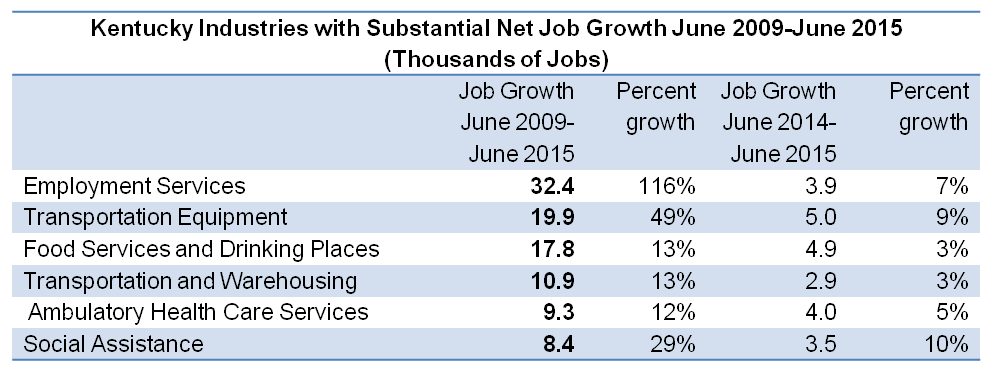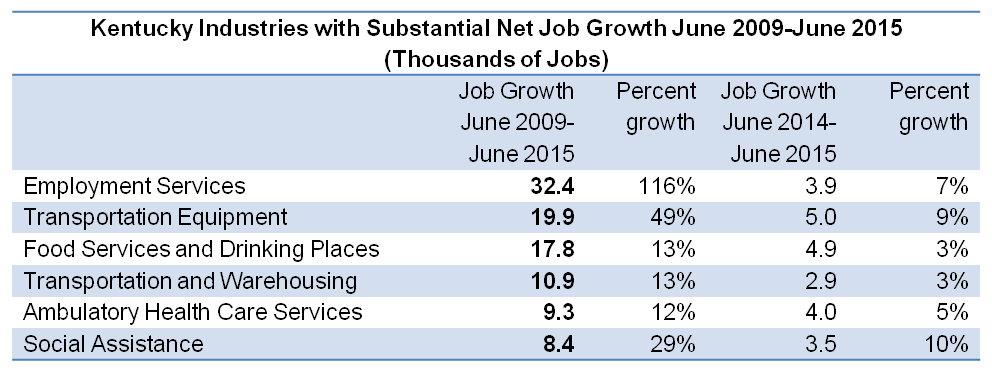After major job loss in the Great Recession, Kentucky’s economy has gradually improved and the state has added 141,000 jobs since June 2009. The pace of job growth has picked up over the last year, with the state adding more jobs since last June than any year since 1999.
When it comes to job quality, though, the story is more complicated with both good and bad news for Kentucky workers. Growth in industries like manufacturing and logistics suggest Kentucky is strengthening its role as a production state. But jobs in some traditionally good-paying industries are changing, while other sectors with strong growth provide much less pay and job security. These trends raise important questions about whether new jobs being created can sustain Kentucky families.
One area of good news is the rebound in the auto industry. Kentucky gained 19,900 jobs in that sector over the last six years, or growth of 49 percent, from 41,000 jobs to 60,900. Growth was strong both in auto parts (49 percent) and assembly (54 percent). The auto industry has experienced revival due to the federal government’s financial rescue, restructuring of the industry, on-shoring of some production and Kentucky’s strong supply chain. Average weekly pay in the industry in Kentucky is an impressive $1,182, although new jobs typically pay less than existing jobs.
Related to recovery in manufacturing nationwide, along with increases in consumer spending, is growth in transportation and warehousing jobs. Jobs in that sector have increased by 10,900, or 13 percent, since 2009. Kentucky’s location makes it a key state in that industry. Average pay is $964 a week.
However, the single industry that has had the most job growth is far less encouraging: employment services made up primarily of temporary agencies. The state saw 32,400 new jobs in employment services over the last five years (meaning one in five of the net new jobs created), or growth of 116 percent. Traditionally associated with service businesses, temp agencies are increasingly used to staff manufacturing industries as well — including the auto industry.
Jobs provided through temp agencies typically have lower pay, receive less training and are associated with poorer working conditions. Average weekly pay in this sector in Kentucky is just $449 a month. An important question is the extent to which the explosion in temporary jobs reflects the early stages of the recovery — with industries making more jobs permanent as the recovery advances — versus a permanent change in businesses’ staffing patterns.
Among other lower-paying industries that have added substantial employment, food services and drinking places (primarily restaurants, both full-service and fast food) have added 17,800 jobs. Average pay in that industry is only $289 a week compared to $836 for all industries. Fast food workers have become widely-recognized symbols of a low-wage economy, and many tipped restaurant workers struggle to make ends meet.
Some health-related services have also had strong job growth. Kentucky added 9,300 jobs over the last six years in ambulatory health care services, meaning doctors’ and dentists’ offices and other outpatient health care facilities. Growth is particularly strong in the last year, with health care reform and especially the Medicaid expansion likely playing a role. The state has also added 8,400 jobs in the social assistance sector including care services for the elderly and disabled. Average private sector weekly pay in the latter industry is only $340.
Overall, the recovery is a mixed story for job quality in the state. Growth in factory jobs re-solidifies Kentucky as a leading manufacturing state, as does related growth in transportation and warehousing. But gains in some low-wage service sectors and the rise of contingent employment across the economy mean some Kentuckians are taking on jobs that don’t pay well or provide the economic security they seek.
Source: KCEP analysis of Bureau of Labor Statistics Current Employment Statistics data. Wage data in blog are latest available from the Quarterly Census of Employment and Wages.





